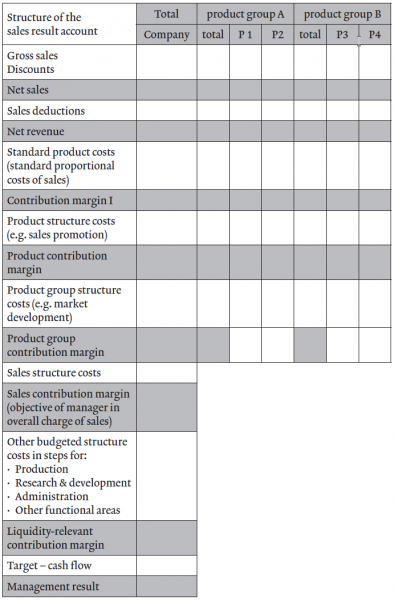Contribution accounting (Direct Costing and multi-step)
From ControllingWiki
Contents
IGC-DEFINITION (abbreviated)
Contribution accounting (Direct Costing and multi-step) / Deckungsbeitragsrechnung (ein- und mehrstufig)
Contribution accounting is the tool for planning and controlling the business’s activities towards the profit objective. Its task is twofold:
- to enable managers to have a better understanding of the effects their decisions are likely to have on profits (decision accounting);
- to convert objectives into figures to provide performance ratings for managers (responsibility accounting).
Contribution accounting involves the linking of a market-oriented philosophy with economic quantities and values; it leads to a way of thinking that starts with the customer perspective. A well-developed contribution accounting system therefore provides the necessary transparency and shows whether market planning as well as technical and organisational structures are moving collectively towards the profit goal.
Stepwise contribution accounting
Since structure costs do not alter in direct proportion to the number of items sold or produced, it is not possible to calculate the genuine full costs of any product unit. Consequently, the system of stepwise contribution accounting was developed to improve the possibilities of analysing and controlling costs.
Starting from the CM I, blocks of structure costs are deducted one after another, based on their relationship to the object in question (e.g. product or product group). This multiple calculation of subsequent contribution margins allocates structure costs without applying a key. It is still not possible to see how much a particular item has brought in in terms of profit, but the contribution which an article, a product, or a product group or a range of goods makes towards the covering of the structure costs can be calculated as a figure that can be planned, controlled and for which somebody can be made accountable.
Sales result account
Using the method of stepwise contribution accounting for structuring a sales result account offers many insights for managing and measuring costs and sales performance. The aim of a sales result account is to show the results and the degree of success of one or more sales organisations according to individual sources of profit. For this purpose, all cost factors have to be isolated which cannot be influenced by the sales organization. For this reason, the production costs in the sales result account are always calculated at standard rates, i.e. as planned, then deducted from the net revenue. The structure costs of other functional areas are always deducted as planned values (in budget and actuals).
Therefore any variances between budgeted and actual figures, for which sales is not responsible do not appear in the sales result account, but are shown in the variances résumé.
The number of contribution steps depends on the organisational structure of the business – its areas of responsibility are reflected in the structure of the CM steps. Since multi-dimensional contribution accounting is now more frequent and the structure of the contribution account differs for each company, it is a good idea not just to number the various contributions but also to provide them with descriptive names.
from: IGC-Controller-Wörterbuch, International Group of Controlling (Hrsg.)
Source
A Bicycle Nomad Prepares for Re-entry
In 2010, Manjula Martin and her partner set out to see the world the old-fashioned way: by bicycle. With little money, no itinerary, gadgets or training, they traversed five countries and 3,500 miles and discovered a world filled with generosity. In this article, Manjula Martin describes the transition from bike to home with four rules for re-entry that are strikingly authentic, grounded, and universal.
[A Bicycle Nomad Prepares for Re-entry]
[GoodvilleNews.com - good, positive news, inspirational stories, articles]
9-yr-old Helps Disabled Brother Finish Triathlons
Over the weekend, brothers Cayden and Connor Long joined hundreds of other children as they competed in the first annual New England Kids Triathlon in Cambridge. The boys did not win the event -- they didnt even come close. But that didnt stop them from winning hearts across the Internet. The Long brothers are not your typical triathletes. Six-year-old Cayden has cerebral palsy and can neither walk nor talk. But thanks to the dedication of his older brother, Connor, the young boy has participated in several triathlons. A touching video
[9-yr-old Helps Disabled Brother Finish Triathlons]
[GoodvilleNews.com - good, positive news, inspirational stories, articles]
5 Principles for Inner Transformation at Work
People go to work to sustain themselves and produce value in the world. Yet work environments can also be stressful, filled with challenging responsibilities and personalities, and feel misaligned with our most deeply cherished values. Instead of sustaining us, the workplace can sometimes feel simply draining, and at worst, unwholesome for both ourselves and the world.
[5 Principles for Inner Transformation at Work]
[GoodvilleNews.com - good, positive news, inspirational stories, articles]
A Quick Guide To The Art of Listening
The most basic of all human needs is the need to understand and be understood. The best way to understand people is to listen to them. Ralph Nichols
[A Quick Guide To The Art of Listening]
[GoodvilleNews.com - good, positive news, inspirational stories, articles]
Microbial Oasis Discovered Beneath the Atacama Desert
Two metres below the surface of the Atacama Desert there is an oasis of microorganisms. Researchers from the Center of Astrobiology (Spain) and the Catholic University of the North in Chile have found it in hypersaline substrates thanks to SOLID, a detector for signs of life which could be used in environments similar to subsoil on Mars.
[Microbial Oasis Discovered Beneath the Atacama Desert]
[GoodvilleNews.com - good, positive news, inspirational stories, articles]
